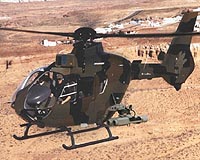| . |  |
. |
Beirut, Lebanon (UPI) Feb 19, 2009 The United States is reported ready to provide light attack aircraft to the Lebanese army and to establish an elite Special Forces unit, a major step toward boosting the military's now-feeble firepower. If the reports are accurate, these moves would also bolster the army, a pivotal multi-sect state institution in a country riven by sectarian rivalry, to counter the power of Iran's key ally in the Levant, the Shiite Hezbollah. The Americans have been providing Lebanon's military with largely non-lethal equipment since the end of the 1975-90 civil war. But the process accelerated after the Feb. 14, 2005, assassination of former Prime Minister Rafik Hariri and the subsequent withdrawal of Syrian military forces, which had been deployed in Lebanon for nearly 30 years. The apparent change in U.S. policy regarding upgrading the capabilities of the Lebanese military coincided with a rapprochement of sorts between Washington and Damascus. Syria, Iran's key Arab ally, was widely blamed for the Hariri assassination, particularly by the administration of U.S. President George W. Bush. It branded Syria as part of the "axis of evil" with Iran and North Korea and withdrew its ambassador from Damascus after Hariri was killed. Now, after months of painstaking negotiation by the administration of U.S. President Barack Obama, the United States has appointed a new ambassador amid expectations normal relations can be restored. Lebanon has a minuscule air force that comprises two 1950s-era British-built Hawker Hunter fighter jets, both currently grounded, and 58 helicopters. These are 13 French-built SA-3241 Aerospatiale Gazelle helicopters, five of them non-operational, and 45 utility/transport helicopters. These include 16 U.S.-supplied Bell UH-1H Vietnam-era Hueys -- seven of them unserviceable -- and a motley collection of Aerospatiale Puma and Alouette II and III craft, most of which are grounded. None of these aircraft have air-to-ground attack capabilities. During three months of urban fighting in 2007 in northern Lebanon between the army and Islamist militants -- in which 170 soldiers were killed -- helicopters were turned into makeshift attack platforms with crews manhandling bombs out the side doors. Beirut's leftist As-Safir newspaper reports that the Pentagon has proposed supplying the Lebanese with Hawker-Beechcraft AT-6 or Brazilian-built Embraer Super Tucano propeller-driven aircraft to bolsters its reconnaissance and counter-insurgency capabilities. The proposal was reportedly made during talks in Washington between Defense Minister Elias Murr, heading a Lebanese military delegation, and U.S. military chiefs, including Secretary of Defense Robert Gates. Since 2005, Washington has provided Lebanon with military aid worth $500 million, primarily to bolster anti-Syrian forces. But increasingly Lebanese officials, from President Michel Suleiman on down, have complained that little of this largess enables the military to defend the state against Israel, with the most powerful military in the region, or to counter terrorism. Murr specifically criticized Washington for not providing Lebanon with combat aircraft. "If we'd had aircraft" during the 2007 fighting "we would not have lost one martyr from the army," he said. Washington, of course, does not want to provide the Lebanese army with advanced weapons that could be used against Israel, which violates Lebanese airspace almost daily opposed only by obsolete line-of-sight anti-aircraft guns. Nor does it want these to fall into the hands of Hezbollah, which is a far more capable, combat-tested fighting force than the army. The Lebanese, then, have looked elsewhere for firepower. Last year Russia offered, free of charge, 10 MiG-29 supersonic interceptors, and Iran, which arms Hezbollah, has offered aircraft and missiles. Nonetheless, the prospect of a combat-capable air force able to stand up to Israel's top-of-the-line Lockheed Martin F-16s and Boeing F-15s and their seasoned pilots remains extremely distant. Less so is the special group the U.S. security consultancy Stratfor says the Pentagon wants to establish as an elite army unit. Its main function will be countering Hezbollah. That could lead to a potentially explosive political confrontation that many Lebanese want to avoid. At present, the army remains weak -- kept that way by Lebanese political barons who do not want their power threatened -- and fractious, heavily penetrated by Hezbollah sympathizers. "The new unit is expected to selectively recruit and its leadership will consist almost entirely of Maronite Christians and Sunni from Akkar in northern Lebanon, among which Hezbollah has little sway," Stratfor said.
Share This Article With Planet Earth
Related Links The Military Industrial Complex at SpaceWar.com Learn about the Superpowers of the 21st Century at SpaceWar.com
 Eurocopter focuses on Indian market
Eurocopter focuses on Indian marketNew Delhi (UPI) Feb 19, 2009 Eurocopter announced its intention to bid for more major helicopter contracts with the Indian military that could be worth up to $8 billion. As part of its increased drive into the country's helicopter market Eurocopter will set up a maintenance, repair and overhaul center for its Dauphin helicopter. The center will be near either Mumbai or New Delhi and be a joint venture with India's ... read more |
|
| The content herein, unless otherwise known to be public domain, are Copyright 1995-2010 - SpaceDaily. AFP and UPI Wire Stories are copyright Agence France-Presse and United Press International. ESA Portal Reports are copyright European Space Agency. All NASA sourced material is public domain. Additional copyrights may apply in whole or part to other bona fide parties. Advertising does not imply endorsement,agreement or approval of any opinions, statements or information provided by SpaceDaily on any Web page published or hosted by SpaceDaily. Privacy Statement |